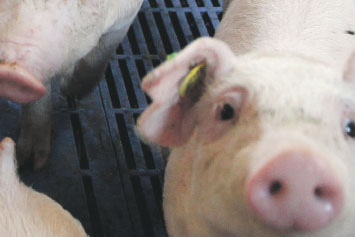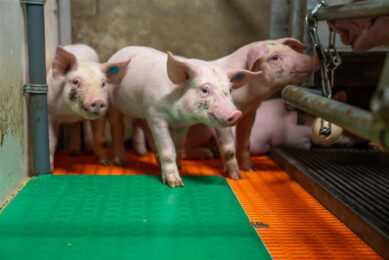Breeding against Oedema disease in Switzerland

It’s a matter of genetics: Not all pigs are susceptible to oedema disease. What happens if a breeding programme could make all piglets resistant to oedema disease? A promising initiative in Switzerland embarked on this mission.
Oedema disease is a well-known sickness in piglets and finishing pigs. It can occur shortly after weaning. The course of the disease is very fast and some piglets die within hours or days. Oedema disease is caused by Escherichia coli bacteria of fimbriae type F18, in general. Usual prophylaxis is difficult and not always successful. Offering more crude fibre in the feed after weaning is one way, but farmers with considerable oedema problems often use antibiotics after weaning to prevent the increase of E. coli bacteria before piglets become ill. Using antibiotics as a procedure, however, is critical in pig production. In the 90s, Swiss researchers discovered that some pigs are genetically resistant against E. coli bacteria of fimbriae type F18. The E. coli F18 bacteria adhere to special receptors on the villi with their special fimbriae. In pigs that are homozygous (A/A) at the causative mutation in the FUT1 gene, these receptors on the villi are missing.
Therefore, the E. coli F18 bacteria could not adhere to the villi of these pigs thus avoiding illness (Figure 1). In other words: The key of the bacteria (the fimbriae) does not match to the lock of such genetic resistant pigs anymore. Piglets that should be genetically resistant against E. coli F18 bacteria must inherit a resistant allele from their sire and dam. Swiss pig breeding organisation Suisag is therefore selecting on genetic E. coli F18 resistance in the Swiss Large White damline and its Swiss terminal sire Premo.
Genotyping and selection
The systematic genotyping and selection strategy in Swiss LW started in 2006. New candidates for AI are produced by elite matings in Swiss nucleus farms. The best sows then mate with the new Large White AI boars and male piglets of these elite litters are not castrated after birth. In the past, breeders took an ear tag sample of these boar piglets at two to three weeks of age and sent these to the lab for DNA genotyping. With about 25 kg live weight, some of the boar piglets enter the central dam line boar test of the Swiss breeding organisation. Annually, about 450 Swiss LW boars are tested and nearly 45 go to AI stations or export. The E. coli F18 genotypes are available before the boars are selected for the central test stud. In the initial years, the purchase of homozygous susceptible boars (G/G) was usually avoided. At a later stage, the organisation was able to obtain homozygous resistant boars (A/A) for the central test and AI stations.
The number and proportion of homozygous resistant boars has increased continuously (see Figure 2). Since 2011 all active Swiss LW boars have been homozygous resistant against E. coli F18 bacteria. Over the years the number of homozygous resistant AI boars increased, for use in the nucleus farms and in new elite-matings. If a sire of an elite mating is homozygous, it makes sense to genotype the sow, if her genotype is unknown. If a sow is also homozygous resistant, one knows that all piglets of that litter will be homozygous resistant without expensive genotyping of each single piglet.
In practice, nucleus breeders sent a sample of the sow at the date of insemination of the elite-mating to the lab for genotyping. In short, at farrowing it is clear whether sows are also homozygous or heterozygous after all. Only if sows are heterozygous, genotyping piglets would be necessary.
The number and proportion of sows used in elite matings that were detected to be homozygous increased continously since 2006 and an increasing number of elite litters were known to be homozygous resistant by descent. Frequently, gilts from these elite litters are used for own replacement of the nucleus herds, as they descend from the best dams and secondly they are often known to be homozygous resistant.
Current situation
The strategy to genotype only the best sows that were used for elite matings was efficient. In 2012, 48% of about 11,000 raised and tested Swiss LW gilts in nucleus farms were known to be homozygous resistant by descent. In total, it is safe to assume that more than 75% of all Swiss LW gilts are already homozygous resistant against E. coli F18 bacteria. The number of costly genotyping was remarkably reduced from about 1,500 per year in the past, to less than 300 in 2012, because in most new elite matings the sows and the boars are now known to be homozygous resistant by descent.
In conclusion, the E. coli F18 susceptible allele will be eliminated from the Swiss LW population completely by using only homozygous resistant boars as sires. Today the remaining genotyping costs are low and it is estimated that the need to genotype sows will be further reduced in the next few years.
Sires of finishing piglets
Premo (Suisag) is the name of the Swiss terminal sire to produce finishing pigs and the systematic E. coli F18 genotyping and selecting strategy started in 2010. Sire breeders send ear tag samples of all non-castrated boar piglets at weaning. At about 90 days of age, the organisation decides which samples will be genotyped. About 75% of all samples are genotyped, but samples of boars with very low pedigree breeding values are not sent to the lab, as the probability that such boars will enter the AI station is very low.
By this procedure, the E. coli F18 genotypes of the interesting boars are known when the boars have their own performance test at approximately 145 days of age. Of course, the genotype is taken into account when buying new boars for AI. Currently, no homozygous susceptible boars are bought (G/G) anymore; the organisation prefers homozygous resistant boars (A/A). At the moment, 49 of this line’s boars in the organisation’s AI stations are 3 homozygous resistant (A/A) and the number and proportion is increasing continuously. Suppose all 136 boars produce the same number of finishing pigs. In that case, 62% of the piglets actually inherit the resistant allele from their sire. The values in the other breeds are analogous. The frequency of the resistant allele is increasing by 10% per year.
Therefore, it is expected that there are only homozygous resistant boars at the AI stations within the next 4-5 years. Currently, semen of only homozygous resistant boars is delivered to farms with considerable oedema problems. Therefore, the number and proportion of genetically resistant piglets increases considerably four months later. This strategy shows a high success rate in these farms especially if the farms use purebred Large White sows.











